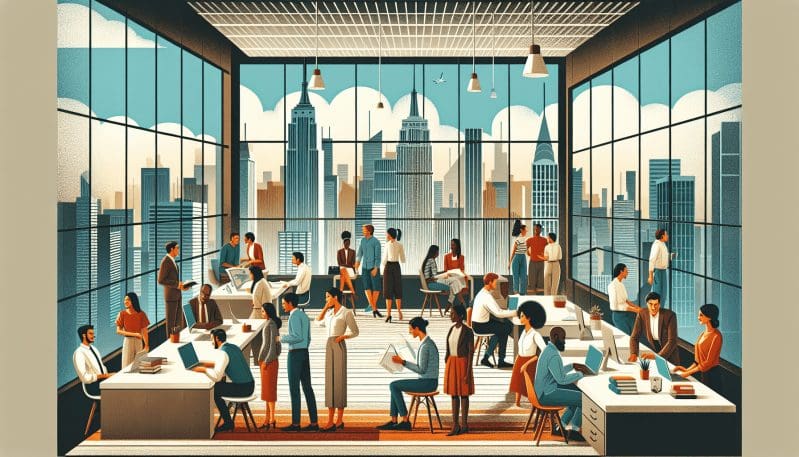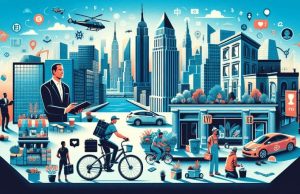As the cultural melting pot of America, New York City prides itself on its diversity. This immense variety in backgrounds, perspectives, and experiences is not just seen on its streets but is often mirrored in the very heart of its workplaces. Despite the aspirational diversity statements and inclusive branding many New York companies boast, the question remains: how much of this is just rhetoric, and how much is reality?
In recent years, diversity and inclusion (D&I) have become more than just buzzwords—they’ve transformed into benchmarks by which companies are judged by potential employees, customers, and investors alike. But how are New York’s workplaces genuinely measuring up to these standards?
### Gender: Striving for Balance
Gender balance in the workplace has seen progress, albeit slow. Many New York companies have made headway in this area, implementing policies that encourage the hiring and promotion of women. However, a closer look at leadership positions and boardrooms across various industries often reveals a stark imbalance. Despite the fact that women constitute nearly half of the workforce, they are significantly underrepresented at the top, indicating a ‘glass ceiling’ that still needs shattering.
### Race and Ethnicity: Beyond Tokenism
New York’s racial and ethnic diversity is perhaps its most defining feature. Yet, in the corridors of corporate power, minorities often encounter a ‘concrete ceiling.’ While some companies demonstrate a commitment to racial and ethnic diversity through recruitment drives and mentorship programs, critics argue that token hires and diversity quotas do not necessarily create a genuinely inclusive environment. Moving beyond tokenism to true representation remains a critical challenge.
### LGBTQ+ Representation: Progressive Policies vs. Practice
The Big Apple is known for its progressive stance on LGBTQ+ rights, and many companies echo this sentiment through their D&I initiatives. However, translating these policies into everyday practice is a different ballgame. LGBTQ+ employees sometimes face subtle discrimination and a lack of understanding from colleagues and management alike, which can hinder their professional growth and sense of belonging.
### Diving into Diversity Initiatives
Investment in D&I initiatives has undoubtedly skyrocketed, with companies rolling out training programs, affinity groups, and hiring practices intended to bolster underrepresented groups. Are these initiatives making a significant impact, or are they merely box-checking exercises? Analyzing the effectiveness of these programs is key to understanding their true value.
### Hiring Practices: Are They Truly Inclusive?
In the bid to create diverse teams, employers often revamp their hiring practices. Blind recruitment, diversity recruitment agencies, and targeted outreach programs are part of the arsenal employed to attract a varied workforce. Yet, the retention and advancement rates of these hires must also be scrutinized to gauge the success of these practices.
### Workplace Culture: The Bedrock of Inclusion
The culture of a workplace often dictates the everyday experiences of its employees. A truly inclusive culture goes beyond mere tolerance of differences—it celebrates them. It is a culture where diversity thrives in the daily dialogue and decision-making processes. Unfortunately, many companies struggle to cultivate such an environment, leading to a workforce that may be diverse in appearance but not in practice.
### Measuring Up to New York’s Demographics
New York’s demographic diversity is well-documented, but does this diversity reflect in the city’s workplaces? There is a noticeable mismatch in many sectors, with certain groups remaining underrepresented, especially in senior roles. Companies must confront this disparity head-on if they are to bridge the gap between their diversity promises and the real-life composition of their workforce.
### Bridging the Gap: From Rhetoric to Reality
The road from espousing values of diversity to actualizing them is fraught with challenges. While some companies are making concerted efforts to align their workforce with their diversity rhetoric, others are lagging far behind. For real change to occur, these values must permeate every level of an organization—hiring, promotion, company culture—and be backed by accountability and transparent reporting.
Taking stock of New York’s employment landscape, it is evident that while strides have been made in D&I, there remains a significant gap between the utopian rhetoric of diversity and the complex reality. As companies grapple with this disparity, the workforce continues to navigate a landscape that is, at times, at odds with the inclusive future it promises. For New York’s workplaces to truly reflect the diversity of the city itself, a shift from performative gestures to substantive, systemic change is essential. Only then can the workplace become a true microcosm of the vibrant, diverse, and inclusive city that New York aspires to be.

























